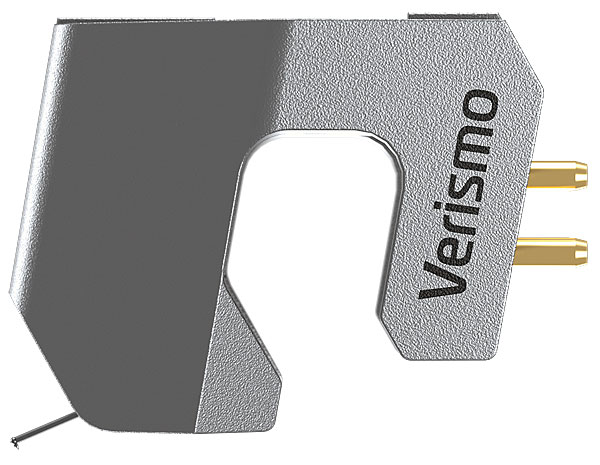Ortofon MC Verismo Cartridge

 Precision manufacturing, state-of-the-art materials and magnet technologies combine in this new addition to the 'Exclusives' MC range – the ultimate blend of art and science?
Precision manufacturing, state-of-the-art materials and magnet technologies combine in this new addition to the 'Exclusives' MC range – the ultimate blend of art and science?
Talk about alpha to omega: we've looked at two Ortofon cartridges this month, the £295 2M Bronze supplied with Thorens' TD 1500 and now the MC Verismo moving-coil, at £5349. It's the latest MC in Ortofon's 'Exclusives' series, which already includes the £6999 MC Anna Diamond [HFN Oct '19] and £3799 MC Windfeld Ti [HFN Jan '18], but with an open body shape first pioneered in this Danish brand's MC A90 [HFN Sep '09].
Family Traits
Despite the difference in shape, the Verismo shares some mechanical technology with the Anna Diamond, so if you're shopping in this rarefied sector, you'll want to know the trade-offs. There are similarities in the two 'Wide Range Damping' systems employed at the cantilever's fulcrum but the coils and magnet assemblies are distinct, the Verismo employing gold-plated copper in the former and a Field Stabilising Element (FSE) in the latter. Otherwise, both MCs require a 10ohm load and have identical claimed outputs of 0.2mV. Compliance differs, however, with the MC Verismo specified at a slightly softer 13µm/mN while the MC Anna Diamond is a lower 9µm/mN.
Furthermore, the MC Verismo weighs 9.5g while the MC Anna Diamond is a far heftier 16g and the newer cartridge requires a downforce of 2.5g-2.8g, with 2.6g sounding optimal, while the MC Anna Diamond gets away with 'just' 2.4g. These numbers came into play for me as I have access to four suitable tonearms of varying effective mass, including detachable headshells whose weight also varies by as much as 10g.
As the body colour conveys, the MC Verismo's open housing is fashioned from titanium by 'Selective Laser Melting (SLM)', a technique pioneered by Ortofon and also used for the MC Anna in its two-part body. In addition to dealing with the hardness, SLM has enabled Ortofon to control the density and thus the damping properties of the body material.
Proprietary Diamond
While its name suggests a movie starring Schwarzenegger or Van Damme, the chosen 'Replicant 100' line contact stylus features a long, narrow surface with minor/major stylus tip radii of 5/100µm. It's also featured on the MC Anna (Diamond) along with a very similar diamond cantilever. So, once again, I find myself with a cartridge fitted with a gemstone cantilever, the AVID Ruby Reference [HFN Nov '20] being our last memorable example.

All cantilevers impart a 'sound'. With diamond cantilevers, there's typically a – don't groan, please – cut-glass precision which improves transient attack from mid-treble on up, and I've also detected better resolution of minuscule details with MCs employing diamond or even ruby cantilevers.
As Infinity's Arnie Nudell told me decades ago, retrieval of fine detail is just as essential in the recreation of a soundstage as is channel separation, which might partially explain why this thing made its presentation seem positively cavernous. In this respect, the MC Verismo reminded me of two classic MCs – Ortofon's own SPU [HFN Jul '21] and the equally venerable Denon DL 103 [HFN Jul '09], an ability I'm pleased to report hasn't been lost in the modernisation that's yielded this futuristic design.
Bring On The Style
The MC Verismo, too, is the coolest-looking cartridge I've seen since EAT's Jo No5 [HFN Dec '18]. It screams 21st century both in its shape and in physical details which will please inveterate cartridge swappers. The profile itself relates to matters of shielding, damping, weight and internal isolation, while the top affords the increasingly-popular three-point contact, last seen in Vertere's Sabre [HFN Feb '22].
Ortofon's explanation is consistent with this new trend: three well-defined points of contact ensure that the mechanical integration of the cartridge and the headshell is always absolutely perfect. If one is a technical simpleton such as I, the analogy is a three- versus four-legged stool. I know which I'd prefer to level.
Gains imparted by a three-point contact surface are said to be 'a significant and breathtaking increase in dynamics, resolution, and richness in detail'. A familiar patter, but there's no way to challenge it unless you are able to compare two identical cartridges, one with a smooth, flat top and one bearing three contact points. Currently, I'm taking it on faith!
Also making life a bit easier for the installer are beefier pins for better contact and grip. Neither is there a need to remember which lead is L+ or R- thanks to the pins' bold colour coding. Better still, to assuage one's foreboding sense of doom when handling cartridges that cost this much, its naked cantilever is so truly 'al fresco' that even a myopic oldie such as I can align and cue it with ease.


















































